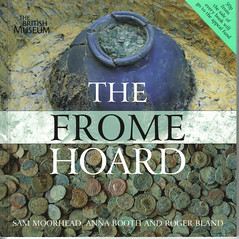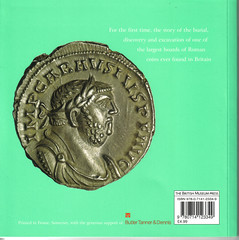
PREV ARTICLE
NEXT ARTICLE
FULL ISSUE
PREV FULL ISSUE
BOOK REVIEW: THE FROME HOARD
Jeff Reichenberger submitted this review of a British Museum publication on the Frome Hoard. Thanks!
-Editor


The Frome Hoard is the name given to a hoard of third century ancient coins found in the town of Frome, Somerset County, Great Britain. It is also the title of the book published by the British Museum that chronicles the important find. The book breaks the story into nine chapters divided amongst 48 pages. There are two pages of acknowledgements, which emphasize the outstanding cooperation between many individuals and organizations in the discovery, excavation, and conservation of the hoard. Indeed, the often disputed claims between the finder, land owner, and government authorities that are regularly reported with such discoveries, is simply not a factor in the story of the Frome Hoard. The first two chapters follow the discovery, excavation, conservation, and study of the coins. Discovered treasure stories are always compelling and this one is no exception. On April 9, 2010, Dave Crisp, a seasoned metal detectorist, was searching a grown over pasture that was at one time a ploughed field, with permission of the landowners. He located a scattering of fourth century Roman Siliquae. Two days later he returned to the site, and working into the field approximately 100 meters from the first find, he heard a signal. “Upon digging a small hole to investigate further he realized that he had hit the top of a pottery vessel containing some bronze coins. Recognizing that he might be dealing with a hoard, he dug no further, filled the hole back in and decided to report his find immediately so that it could be excavated by archaeologists.” The excavation procedure is fascinating including the removal of the topsoil, digging around natural brown soil of the original pit, the revealed size and shape of the gray clay pot and the finding of its lid. The onion-shaped pot was cracked but complete, and measured approximately 24 inches in height and 18 inches in diameter, and completely filled with coins. The exterior of the pot had been carefully packed with some kind of preserving plant material. The coins were removed in layers when it was determined that the pot was too fragile to move en bloc. Of course all of these steps and more are well photographed and supplemented with illustrations of how the pot rested underground. The middle chapters cover the circumstances of the burial, the cleaning, sorting and attribution of the coins. Among the 52,503 coins there are 10 mints, 26 rulers, and 40 years (AD 253 – 293) represented, as well as the Central, Gallic, and British Roman empires. The majority of the coins are base silver radiates containing less than 5 % silver. It's interesting to note the distribution of coins by layer in conjunction with the rulers and years represented. Coins of one ruler, the British Emperor Carausius, were found in large concentration in the 16th layer, just over halfway down the pot. The coins of Carausius are previously known to be scarce and in fact, five rare silver denarii were found among nearly 800 radiates. The final chapters cover the Emperor Carausius and his significance to Britain, other British coin hoards and what comes next for the Frome Hoard. I loved the book - it's well written, and beautifully illustrated with maps, diagrams, or photos on every page. A light read, but fascinating in all the aspects of what happens when an important hoard is discovered. I enjoyed learning little tidbits such as the fact that, while the Frome Hoard is the largest ever found in a single container, hoards of radiate coins of the period are very common in Britain, nearly 600 such hoards are known, which is the greatest concentration of finds in the Roman Empire. Also, the authors contend that the hoard was probably not buried with the intent to later recover the treasure, but rather as a sacrifice to the gods for agricultural prosperity. The hoard was declared Treasure under the terms of the 1996 Treasure Act and property of the Crown. However, they are offered to museums to acquire. The Somerset County Heritage Service is in the process of acquiring the find. (Part of the proceeds of the book go to the funding.) Then valuation of the coins will be established and proper compensation distributed to Dave Crisp and the landowners. Once the hoard has been entirely cleaned (conservators estimate another year), studied, and attributed, it will be on display at British museums. There is no indication or speculation in the book that any of the coins, no matter how common, will enter the marketplace.
The book itself is square and measures 7.5 x 7.5 inches, perfect bound with a heavy gloss card cover. Inside pages are matte finish making for outstanding photographic quality. The last pages feature a timeline and bibliography. Written by Sam Moorhead, National Finds Advisor of the British Museum, Anna Booth, Somerset County Finds Liaison Officer, and Roger Bland, Head of the Department of Treasure at the British Museum. The book costs a mere $7.85 and that includes shipping!! It can be ordered directly from the British Museum at
britishmuseum.org
.
The Numismatic Bibliomania Society is a non-profit organization promoting numismatic literature. See our web site at coinbooks.org. To submit items for publication in The E-Sylum, write to the Editor at this address: whomren@gmail.com To subscribe go to: https://my.binhost.com/lists/listinfo/esylum All Rights Reserved. NBS Home Page Contact the NBS webmaster 
|